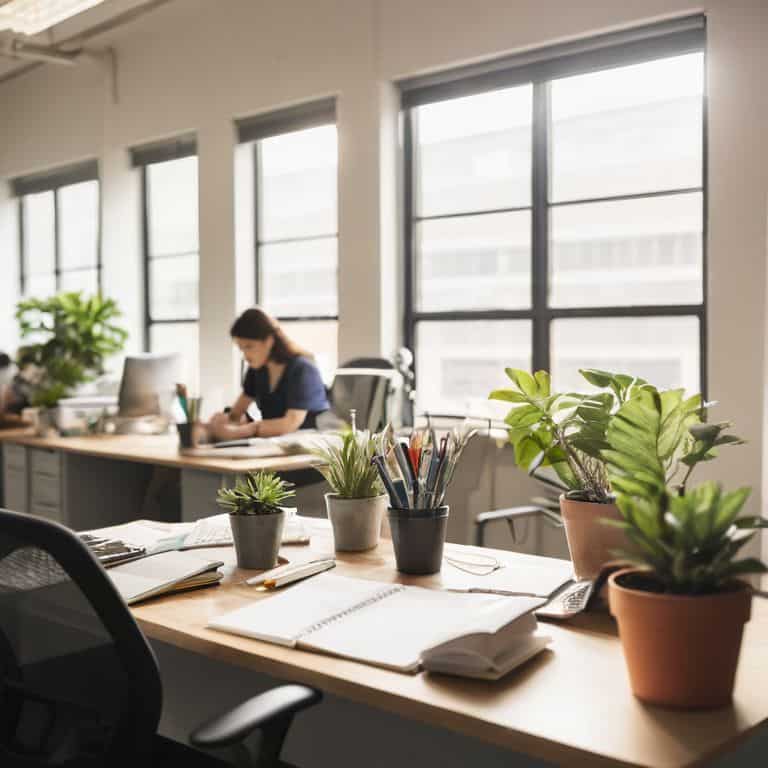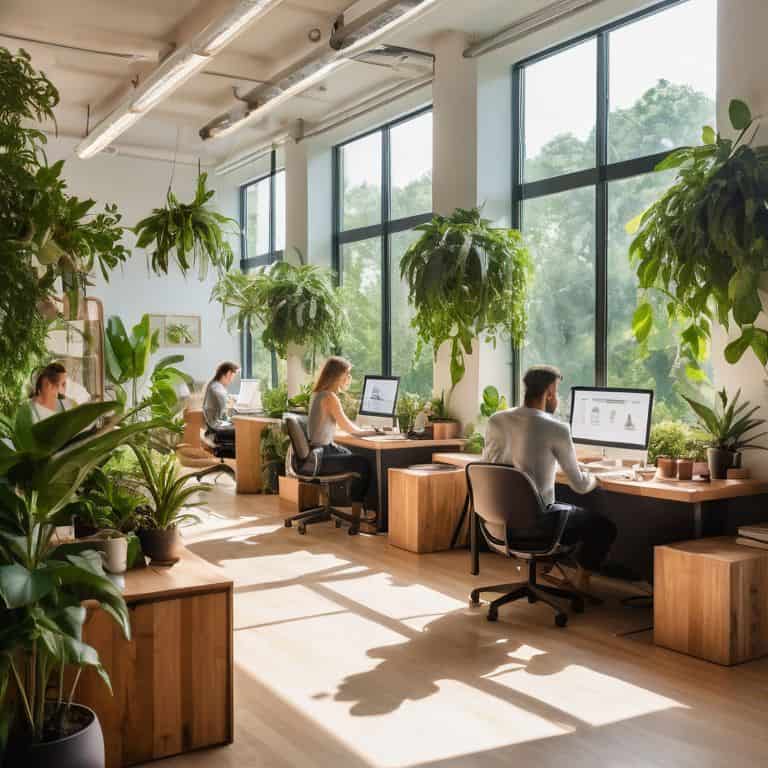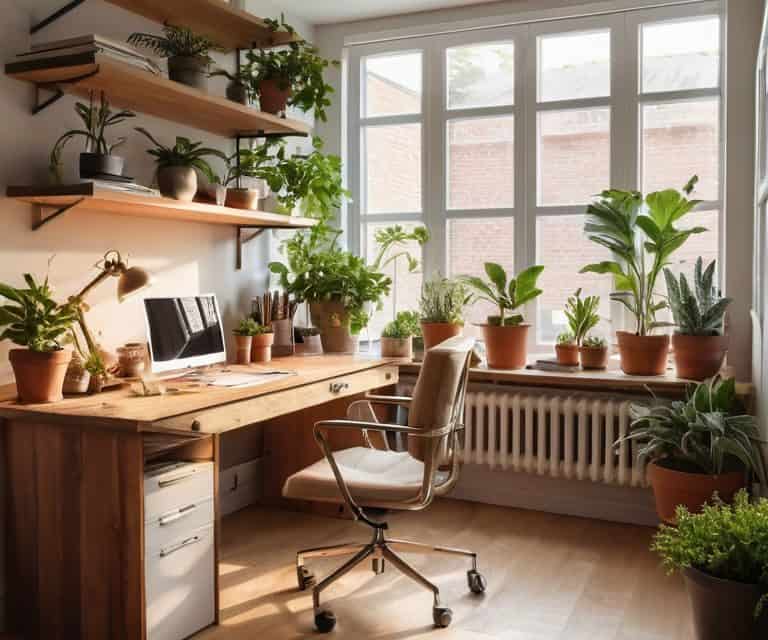I still remember the day I hit rock bottom as a digital marketer – my workspace had become a source of stress rather than inspiration. I had bought into the myth that a healthy workspace environment was a luxury, not a necessity. But as I learned the hard way, creating a healthy workspace environment is crucial for avoiding burnout and cultivating a sense of well-being. It’s a lesson I’ve carried with me into my work as a burnout recovery coach, where I help online entrepreneurs create spaces that nourish their minds, bodies, and souls.
As someone who’s been in your shoes, I want to assure you that it’s possible to transform your workspace into a haven of productivity and calm. In this article, I’ll share practical, psychology-backed strategies for creating a healthy workspace environment that will help you thrive, not just survive. You can expect honest, no-hype advice on how to prioritize your well-being, set healthy boundaries, and design a space that supports your unique needs and goals. By the end of this guide, you’ll have a clear roadmap for crafting a workspace that truly feels like a reflection of your best self.
Table of Contents
Guide Overview: What You'll Need

Total Time: 2 hours 30 minutes
Estimated Cost: $50 – $100
Difficulty Level: Intermediate
Tools Required
- Air Purifier (optional)
- Standing Desk Converter (for existing desk)
- Power Drill (for assembling furniture)
- Measuring Tape (for accurate measurements)
- Level (for ensuring surfaces are even)
Supplies & Materials
- Ergonomic Chair (for proper back support)
- Small Plants (for air purification and aesthetics)
- White Noise Machine (optional)
- 6 inches LED Desk Lamp (for task lighting)
- Comfortable Flooring (such as a mat or rug)
Step-by-Step Instructions
- 1. First, assess your current workspace by taking a step back and observing your surroundings. Take note of the lighting, temperature, and noise level in your workspace. Consider how these factors make you feel and whether they support or hinder your productivity. Ask yourself, what changes can I make to create a more comfortable environment?
- 2. Next, declutter and organize your space to reduce stress and increase focus. Start by sorting through your belongings and getting rid of anything unnecessary or distracting. Use storage containers and labels to keep your workspace tidy and make it easier to find what you need. Remember, a cluttered space can lead to a cluttered mind, so take the time to create a peaceful and organized environment.
- 3. Then, incorporate natural elements into your workspace to promote a sense of calm and well-being. This can be as simple as adding a plant or two, or using a nature-inspired wallpaper or mural. Consider the benefits of biophilic design, which can help reduce stress and improve your mood. If possible, position your workspace near a window to take advantage of natural light and fresh air.
- 4. After that, prioritize ergonomics to prevent physical discomfort and injury. Invest in a comfortable and supportive chair, and make sure your desk and computer are at a comfortable height. Consider using a standing desk or a sit-stand workstation to alternate between sitting and standing throughout the day. This can help reduce eye strain, back pain, and other common issues associated with prolonged sitting.
- 5. Next, establish boundaries and routines to maintain a healthy work-life balance. Set regular working hours and stick to them as much as possible. Use a digital calendar to schedule your work and personal time, and make sure to include time for self-care and relaxation. Consider setting aside device-free time each day to reduce distractions and improve your focus.
- 6. Then, create a self-care station in your workspace to promote relaxation and stress relief. This can be a small area with a few comfort items, such as a stress ball, a mindfulness coloring book, or a essential oil diffuser. Use this space to take breaks and practice mindfulness, and make it a habit to visit your self-care station whenever you feel overwhelmed or stressed.
- 7. Finally, review and adjust your workspace regularly to ensure it continues to support your well-being and productivity. Schedule regular check-ins with yourself to assess your workspace and make any necessary changes. Ask yourself, what’s working well and what areas need improvement, and make adjustments accordingly. By regularly evaluating and refining your workspace, you can create a sustainable and supportive environment that helps you thrive in your work and personal life.
Creating Healthy Workspace Environments

As I work with my clients, I’ve noticed that ergonomic office design plays a significant role in their overall well-being. It’s not just about having a comfortable chair, but also about creating a space that promotes good posture and reduces eye strain. I recommend taking the time to assess your workspace and make adjustments as needed. This might include investing in a standing desk or a document holder to keep your screens at a comfortable distance.
In addition to physical comfort, it’s essential to consider the air quality in your workspace. Indoor air pollution solutions can be as simple as adding some greenery to your office or using an air purifier. I’ve found that having a few desk plant care tips up my sleeve can make a big difference in the air quality and overall ambiance of a space. Not only do plants help purify the air, but they also add a touch of natural beauty to an otherwise sterile environment.
When it comes to decorating your office, I’m a big fan of minimalist office decor inspiration. By keeping your space simple and clutter-free, you can reduce distractions and create a sense of calm. This, combined with an abundance of benefits of natural light in offices, can help you stay focused and energized throughout the day. By making a few intentional decisions about your workspace, you can create an environment that supports your physical and mental well-being.
Ergonomic Design for Bliss
As I sit in my own workspace, surrounded by the soothing scent of my indoor herb garden, I’m reminded of the importance of ergonomic design. It’s not just about aesthetics; it’s about creating a space that supports your physical and mental well-being. When your body is comfortable, your mind is free to focus on the tasks at hand. I recommend investing in a good chair, a standing desk, or even a meditation cushion to encourage mindful moments throughout the day.
By incorporating ergonomic elements, you’ll reduce eye strain, improve your posture, and boost your overall energy levels. As someone who’s experienced the debilitating effects of burnout, I can attest to the power of a well-designed workspace. It’s a simple yet profound step towards creating a blissful work environment that nurtures your mind, body, and soul.
Nature Inspired Minimalist Decor
As I sit amidst my own minimalist decor, surrounded by the gentle hues of nature-inspired elements, I’m reminded of the profound impact our surroundings have on our well-being. By incorporating natural textures, such as reclaimed wood or woven fibers, and subtle color palettes that echo the outdoors, we can create a sense of calm and clarity in our workspaces. This thoughtful approach to decor not only promotes relaxation but also fosters creativity and focus.
I encourage you to experiment with minimalist decor that brings the outdoors in – perhaps a small potted herb garden, like my own, or a beautifully crafted wooden desk that adds warmth to your space. By doing so, you’ll be cultivating an environment that nourishes both your mind and body, allowing you to work from a place of serenity and inspiration.
Nurturing Your Workspace: 5 Essential Tips for a Healthy Environment

- Prioritize Natural Light: Position your workspace to maximize natural light, which boosts mood and energy levels
- Minimize Digital Clutter: Implement a ‘touch once’ policy for digital files and schedule regular decluttering sessions to reduce stress
- Incorporate Calming Colors: Choose a soothing color palette for your walls and decor to promote relaxation and focus
- Bring in Greenery: Add plants or a small herb garden to your workspace to purify the air and enhance mental well-being
- Schedule Self-Care Reminders: Color-code and set reminders for non-negotiable rest time and self-care activities to maintain a healthy work-life balance
Key Takeaways for a Thriving Workspace
I’ve learned firsthand that a well-designed workspace can be a powerful tool in preventing burnout, and by incorporating elements like ergonomic furniture and natural light, you can create an environment that nourishes both body and mind
By embracing a minimalist decor approach and bringing in elements of nature, such as plants or a peaceful water feature, you can craft a space that inspires creativity and calm, allowing you to stay focused and productive without sacrificing your well-being
Remember, creating a healthy workspace is not a one-time task, but an ongoing process – by prioritizing self-care, setting realistic boundaries, and continually assessing and adjusting your space to meet your evolving needs, you can build a career that truly sustains you
Cultivating Serenity at Work
A healthy workspace is not just a physical environment, but a sanctuary for the mind and soul – where every element, from the chair you sit on to the air you breathe, conspires to bring out the best in you.
Gabriela Rossi
Conclusion: Crafting Your Sanctuary
As we’ve explored the world of creating a healthy workspace environment, it’s clear that small, intentional changes can add up to make a significant difference in our well-being. From ergonomic design to nature-inspired minimalist decor, each element plays a role in crafting a space that nourishes our minds, bodies, and souls. By prioritizing our health and happiness, we can transform our workspaces into sanctuaries that inspire creativity, productivity, and joy. Whether you’re a remote worker, entrepreneur, or simply someone looking to elevate your home office, remember that every detail matters.
As you embark on your journey to create a healthy workspace environment, I encourage you to be patient, kind, and compassionate with yourself. Celebrate your small wins, and don’t be afraid to try new things. Your space is a reflection of your unique energy and style, and it’s okay if it evolves over time. Remember, the goal is to create a space that feels like home, where you can show up fully, be your amazing self, and thrive. By doing so, you’ll not only enhance your work life but also cultivate a deeper sense of purpose, fulfillment, and bliss.
Frequently Asked Questions
How can I ensure my workspace is well-ventilated and filled with natural light to improve my mood and productivity?
To boost your mood and productivity, I recommend placing your workspace near a window, if possible, and incorporating plants that purify the air. Additionally, consider using a HEPA air purifier and adjusting your window treatments to maximize natural light. These small changes can make a significant difference in creating a refreshing and uplifting environment.
What are some simple and affordable ways to incorporate ergonomic design principles into my existing workspace?
To incorporate ergonomic design into your existing workspace, start by assessing your chair and desk height. Invest in a affordable standing desk converter or a back support cushion. You can also repurpose household items, like a stack of books, to create a makeshift riser for your monitor. These small tweaks can make a big difference in reducing eye strain and improving your posture.
Can you provide examples of nature-inspired minimalist decor that won't distract me from my work or compromise my focus?
I’m a fan of simple, natural elements that promote calmness. Consider adding a small potted plant, a vase with branches, or a nature-inspired art piece to your space. These subtle touches can bring in a sense of serenity without distracting you from your work.
